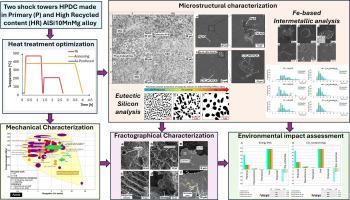The role of high recycled content and heat treatments on microstructure, mechanical properties, and sustainability for an AlSi10MnMg structural automotive component
IF 9.2
2区 工程技术
Q1 ENERGY & FUELS
引用次数: 0
Abstract
Secondary aluminum alloys are produced with end-of-life scraps and are gaining importance for environmental sustainability, thanks to their low intrinsic carbon footprint and energy saving compared to the primary ones. They are increasingly used in the automotive sector for large and complex cast components. However, recycled alloys contaminants like Fe promote the formation of brittle intermetallic compounds, which negatively affect tensile strength and ductility. This study compares the mechanical performance and environmental impact of primary and recycled high pressure die casting AlSi10MnMg (EN AB 43500) alloy under as-produced and heat-treated conditions. Samples were extracted from a die-cast automotive component and subjected to annealing and an optimized T6 heat treatment to balance strength and ductility. Microstructural analysis using field emission scanning electron microscopy revealed a similar pores area fraction, as well as shape, size, and distribution of brittle acicular β-Al5FeSi and polygonal α-Al15(Fe,Mn)3Si2 Fe-rich phases in the primary and recycled alloys under different heat treatment conditions. This similarity justifies the comparable mechanical behavior of the primary and recycled alloy, characterized by limited ductility in the as-produced condition, often insufficient for safety-critical structural components. Heat treatments significantly improved ductility, increasing it by 40–50 % after annealing and nearly doubling it after T6 due to the fragmentation, spheroidization, and coarsening of the eutectic Si. However, the microstructure change reduces strength by a third after annealing and by 20 % after T6, ultimately influencing the final fracture mechanisms. Moreover, heat treatments increase energy consumption, with annealing and T6 leading to about 25 % and 30 % rises, respectively, making them justified only for elongation enhancement.

高回收含量和热处理对AlSi10MnMg结构汽车部件的微观结构、机械性能和可持续性的作用
二次铝合金是用报废的废料生产的,与主要铝合金相比,由于其内在碳足迹低,节能,因此对环境可持续性越来越重要。它们越来越多地用于汽车行业的大型和复杂的铸造部件。然而,回收的合金污染物如铁会促进脆性金属间化合物的形成,从而对拉伸强度和延展性产生负面影响。本研究比较了原生和再生高压压铸AlSi10MnMg (EN AB 43500)合金在生产和热处理条件下的力学性能和环境影响。从汽车压铸件中提取样品,进行退火和优化的T6热处理,以平衡强度和延展性。利用场发射扫描电镜分析发现,不同热处理条件下,原生合金和再生合金的孔隙面积分数、脆针状β-Al5FeSi和多边形α-Al15(Fe,Mn)3Si2富铁相的形状、大小和分布都相似。这种相似性证明了原生合金和再生合金的相似力学性能,其特点是在生产条件下延展性有限,通常不足以用于安全关键的结构部件。热处理显著提高了塑性,退火后的塑性提高了40 - 50%,T6后由于共晶Si的破碎、球化和粗化,塑性提高了近一倍。然而,微观组织的变化使退火后的强度降低了三分之一,T6后的强度降低了20%,最终影响了最终的断裂机制。此外,热处理增加了能量消耗,退火和T6分别导致约25%和30%的增加,这使得它们仅适用于提高伸长率。
本文章由计算机程序翻译,如有差异,请以英文原文为准。
求助全文
约1分钟内获得全文
求助全文
来源期刊

Sustainable Materials and Technologies
Energy-Renewable Energy, Sustainability and the Environment
CiteScore
13.40
自引率
4.20%
发文量
158
审稿时长
45 days
期刊介绍:
Sustainable Materials and Technologies (SM&T), an international, cross-disciplinary, fully open access journal published by Elsevier, focuses on original full-length research articles and reviews. It covers applied or fundamental science of nano-, micro-, meso-, and macro-scale aspects of materials and technologies for sustainable development. SM&T gives special attention to contributions that bridge the knowledge gap between materials and system designs.
 求助内容:
求助内容: 应助结果提醒方式:
应助结果提醒方式:


